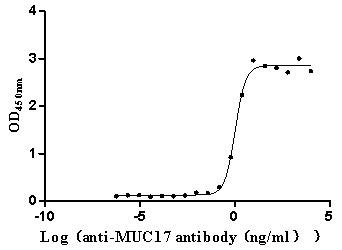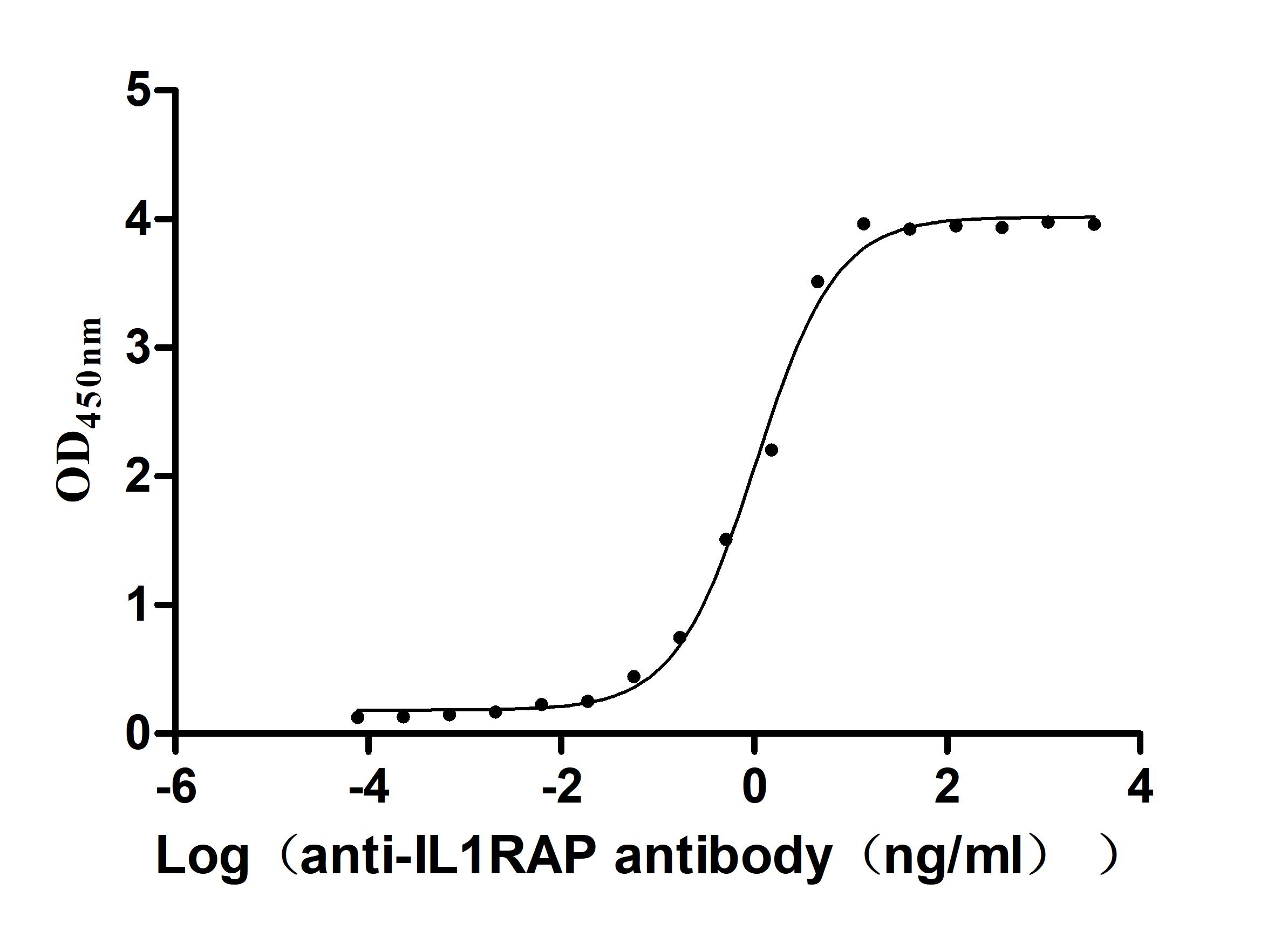Recombinant Mouse Duffy antigen/chemokine receptor (Darc), partial
-
货号:CSB-YP889540MO1
-
规格:
-
来源:Yeast
-
其他:
-
货号:CSB-EP889540MO1
-
规格:
-
来源:E.coli
-
其他:
-
货号:CSB-EP889540MO1-B
-
规格:
-
来源:E.coli
-
共轭:Avi-tag Biotinylated
E. coli biotin ligase (BirA) is highly specific in covalently attaching biotin to the 15 amino acid AviTag peptide. This recombinant protein was biotinylated in vivo by AviTag-BirA technology, which method is BriA catalyzes amide linkage between the biotin and the specific lysine of the AviTag.
-
其他:
-
货号:CSB-BP889540MO1
-
规格:
-
来源:Baculovirus
-
其他:
-
货号:CSB-MP889540MO1
-
规格:
-
来源:Mammalian cell
-
其他:
产品详情
-
纯度:>85% (SDS-PAGE)
-
基因名:
-
Uniprot No.:
-
别名:Ackr1; Darc; Dfy; Fy; Atypical chemokine receptor 1; Duffy antigen/chemokine receptor; CD antigen CD234
-
种属:Mus musculus (Mouse)
-
蛋白长度:Partial
-
蛋白标签:Tag type will be determined during the manufacturing process.
The tag type will be determined during production process. If you have specified tag type, please tell us and we will develop the specified tag preferentially. -
产品提供形式:Lyophilized powder
Note: We will preferentially ship the format that we have in stock, however, if you have any special requirement for the format, please remark your requirement when placing the order, we will prepare according to your demand. -
复溶:We recommend that this vial be briefly centrifuged prior to opening to bring the contents to the bottom. Please reconstitute protein in deionized sterile water to a concentration of 0.1-1.0 mg/mL.We recommend to add 5-50% of glycerol (final concentration) and aliquot for long-term storage at -20℃/-80℃. Our default final concentration of glycerol is 50%. Customers could use it as reference.
-
储存条件:Store at -20°C/-80°C upon receipt, aliquoting is necessary for mutiple use. Avoid repeated freeze-thaw cycles.
-
保质期:The shelf life is related to many factors, storage state, buffer ingredients, storage temperature and the stability of the protein itself.
Generally, the shelf life of liquid form is 6 months at -20°C/-80°C. The shelf life of lyophilized form is 12 months at -20°C/-80°C. -
货期:Delivery time may differ from different purchasing way or location, please kindly consult your local distributors for specific delivery time.Note: All of our proteins are default shipped with normal blue ice packs, if you request to ship with dry ice, please communicate with us in advance and extra fees will be charged.
-
注意事项:Repeated freezing and thawing is not recommended. Store working aliquots at 4°C for up to one week.
-
Datasheet :Please contact us to get it.
相关产品
靶点详情
-
功能:Atypical chemokine receptor that controls chemokine levels and localization via high-affinity chemokine binding that is uncoupled from classic ligand-driven signal transduction cascades, resulting instead in chemokine sequestration, degradation, or transcytosis. Also known as interceptor (internalizing receptor) or chemokine-scavenging receptor or chemokine decoy receptor. Has a promiscuous chemokine-binding profile, interacting with inflammatory chemokines of both the CXC and the CC subfamilies but not with homeostatic chemokines. Acts as a receptor for chemokines including CCL2, CCL5, CCL7, CCL11, CCL13, CCL14, CCL17, CXCL5, CXCL6, IL8/CXCL8, CXCL11, GRO, RANTES, MCP-1 and TARC. May regulate chemokine bioavailability and, consequently, leukocyte recruitment through two distinct mechanisms: when expressed in endothelial cells, it sustains the abluminal to luminal transcytosis of tissue-derived chemokines and their subsequent presentation to circulating leukocytes; when expressed in erythrocytes, serves as blood reservoir of cognate chemokines but also as a chemokine sink, buffering potential surges in plasma chemokine levels.
-
基因功能参考文献:
- Our findings in mice suggest that DARC alters the severity and resolution of AHR. These findings are complimented by our human analyses in which select DARC SNPs are associated with worse asthma control and symptoms. PMID: 28471517
- DARC was exquisitely restricted to post-capillary and small collecting venules and completely absent from arteries, arterioles, capillaries, veins, and most lymphatics in every tissue analyzed. Intravital microscopy showed that adhesive leukocyte-endothelial interactions were restricted to DARC(+) venules. DARC was detectable over the entire circumference of V-ECs, but was more concentrated at cell-cell junctions. PMID: 28526034
- DARC regulates recruitment of osteoclast precursors at the inflammation site PMID: 27376530
- Nucleated erythroid cells had high expression of ACKR1, which facilitated their direct contact with hematopoietic stem cells. The absence of erythroid ACKR1 altered mouse hematopoiesis including stem and progenitor cells, which ultimately gave rise to phenotypically distinct neutrophils that readily left the circulation, causing neutropenia. PMID: 28553950
- The DARC/CD234 is expressed on macrophages and stabilizes CD82 on long-term repopulating hematopoietic stem cells, promoting their quiescence. PMID: 26996598
- Ackr1 deficiency appears to be protective in the ApoE knockout model of atherogenesis, but it is associated with only modest changes in cytokine and chemokine expression as well as T-cell subset frequency and inflammatory macrophage content. PMID: 25858253
- the results suggest that normal motor function and behavior may partly depend on negative regulation of Purkinje cell activity by Ackr1. PMID: 24997773
- Darc plays a role in modulating the regulation of inflammatory response to bone injury and that lack of Darc expression promotes cartilage formation in fracture calluses but does not affect bony union or fracture healing at 21 days post-fracture. PMID: 24146983
- The data showed a role for erythrocyte DARC as a chemokine reservoir and that endothelial DARC contributes to the pathogenesis of experimental autoimmune encephalomyelitis by shuttling chemokines across the blood-brain barrier. PMID: 24625696
- DARC is crucial for chemokine-mediated leukocyte recruitment in vivo. PMID: 20061440
- Plasmodium yoelii uses the murine Duffy antigen receptor for chemokines as a receptor for normocyte invasion and an alternative receptor for reticulocyte invasion. PMID: 11929753
- Vascular endothelial cells may induce Duffy protein to regulate leukocytes and/or chemokine trafficking PMID: 12697152
- role of the Duffy antigen and glycophorin A as receptors for rodent malaria parasite invasion of erythrocytes PMID: 15278442
- we have defined the binding domain on the mDuffy protein for Plasmodium yoelii binding to erythrocytes PMID: 16386320
- DARC functions to clear angiogenic CXC chemokines from the prostate tumor microcirculation PMID: 16394268
- Darc regulates bone mineral density (BMD)negatively by increasing osteoclast formation. Darc is proposed as a candidate gene for chromosome 1 BMD QTL2. PMID: 17416748
- Results indicate that endothelial cell overexpression of mDARC increased leukocyte trafficking to the tumor, reduced the growth of blood vessels into the tumor, and reduced the growth rate of melanoma. PMID: 17942909
- Loss of red cell chemokine scavenging promotes transfusion-related lung inflammation PMID: 19064726
- renal inflammation developed more rapidly in DARC-deficient mice, without affecting the extent of renal injury at later time points PMID: 19498001
- DARC regulates lung inflammation by controlling the distribution and presentation of chemokines that bind CXCR2. PMID: 19499525
显示更多
收起更多
-
亚细胞定位:Early endosome. Recycling endosome. Membrane; Multi-pass membrane protein.
-
蛋白家族:G-protein coupled receptor 1 family, Atypical chemokine receptor subfamily
-
组织特异性:Expressed in liver and brain.
-
数据库链接:
KEGG: mmu:13349
STRING: 10090.ENSMUSP00000045134
UniGene: Mm.6393
Most popular with customers
-
Recombinant Human IGF-like family receptor 1 (IGFLR1), partial (Active)
Express system: Mammalian cell
Species: Homo sapiens (Human)
-
Recombinant Human Interleukin-17A (IL17A) (T26A) (Active)
Express system: Baculovirus
Species: Homo sapiens (Human)
-
Recombinant Human Mucin-17 (MUC17), partial (Active)
Express system: Mammalian cell
Species: Homo sapiens (Human)
-
Recombinant Human Early activation antigen CD69 (CD69), partial (Active)
Express system: Mammalian cell
Species: Homo sapiens (Human)
-
Recombinant Human Interleukin-2 receptor subunit alpha (IL2RA), partial (Active)
Express system: Mammalian cell
Species: Homo sapiens (Human)
-
Recombinant Mouse Gastric inhibitory polypeptide receptor (Gipr), partial (Active)
Express system: Mammalian cell
Species: Mus musculus (Mouse)
-
Recombinant Human Transmembrane 4 L6 family member 1(TM4SF1)-VLPs (Active)
Express system: Mammalian cell
Species: Homo sapiens (Human)
-
Recombinant Macaca fascicularis Interleukin 1 receptor accessory protein(IL1RAP), partial (Active)
Express system: Mammalian cell
Species: Macaca fascicularis (Crab-eating macaque) (Cynomolgus monkey)



-AC1.jpg)
















